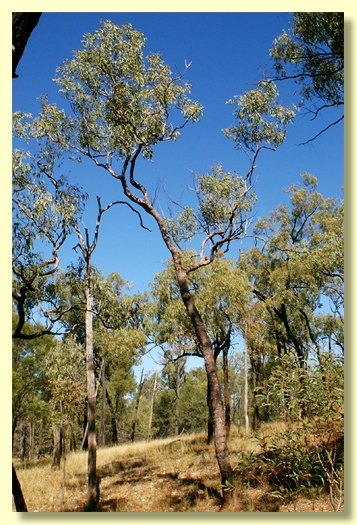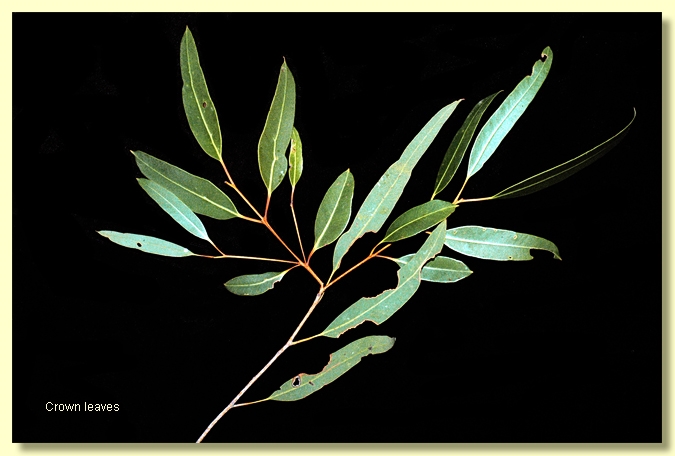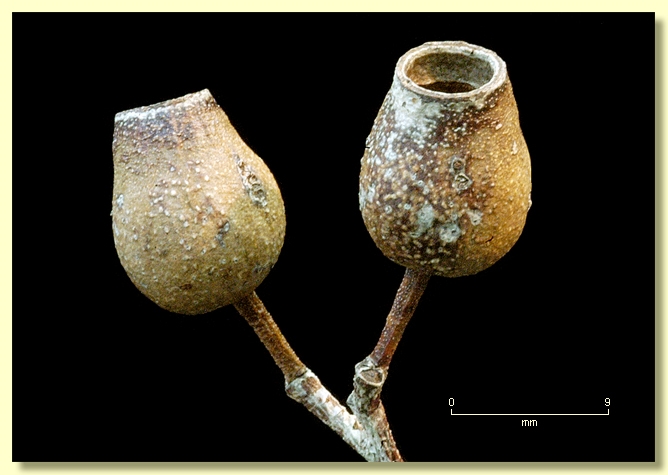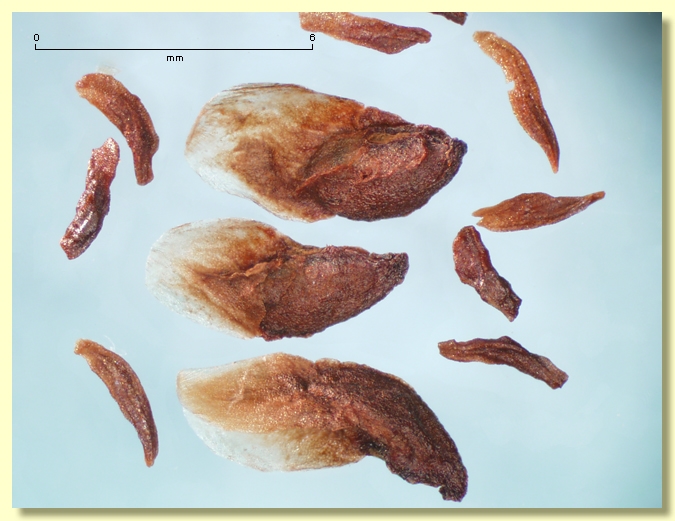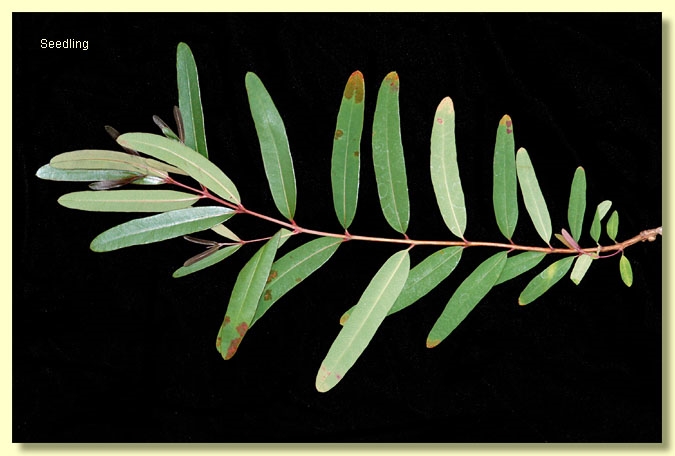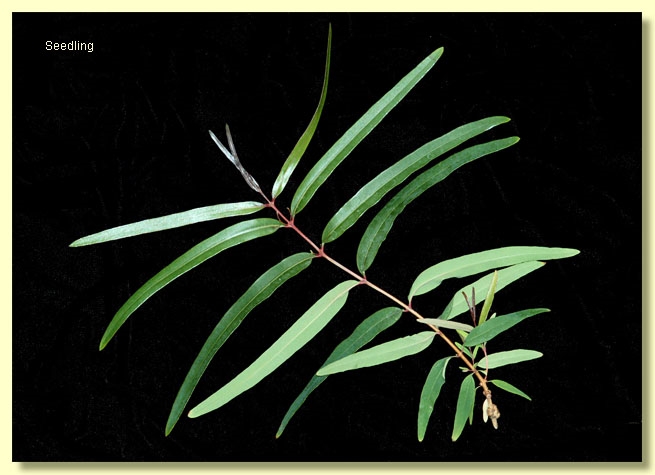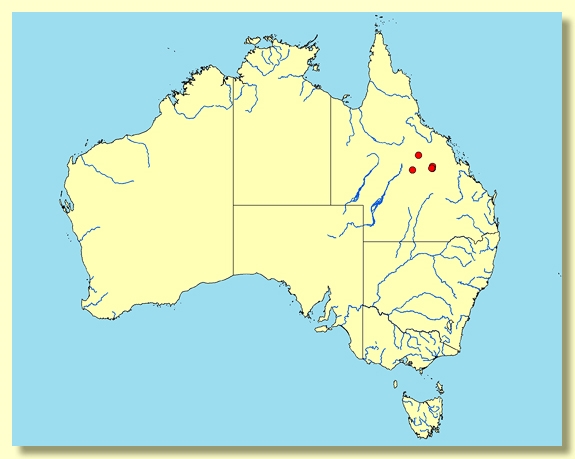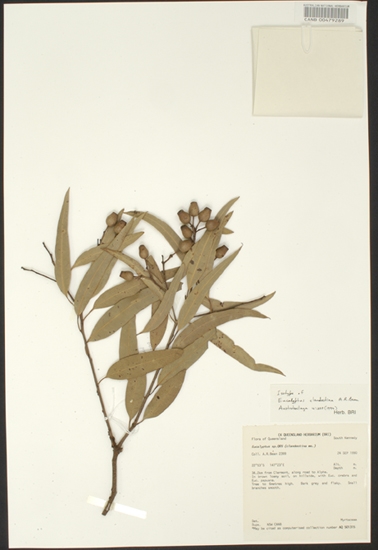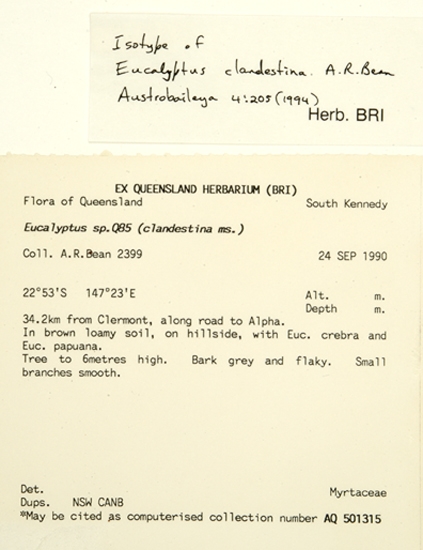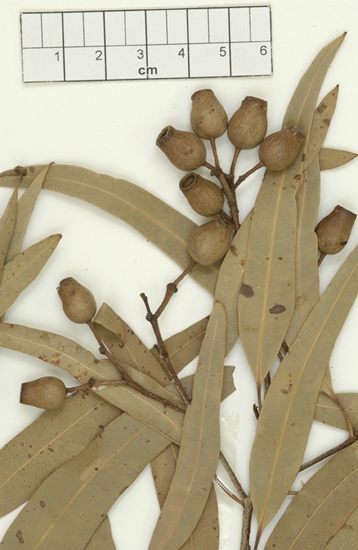Corymbia | Rufaria
Euclid - Online edition
Corymbia clandestina
Corymbia clandestina (A.R.Bean) K.D.Hill & L.A.S.Johnson, Telopea 6: 282 (1995).
Tree to 8 m tall. Forming a lignotuber.
Bark rough and moderately thick over trunk and branches to ca 2–4 cm diameter then flaking off, tessellated, grey to grey-brown.
Branchlets smooth (glabrous); long oil ducts sometimes visible in the pith.
Juvenile growth (coppice or field seedlings to 50 cm): stems rounded in cross-section, smooth; juvenile leaves always shortly petiolate, opposite to sub-opposite becoming alternate, narrowly lanceolate, 5.5–10.5 cm long, 0.8–1.6 cm wide, base tapering to petiole, apex rounded or pointed, green, discolorous, glabrous, slightly glossy.
Adult leaves opposite, sub-opposite or alternate, petioles 0.8–1.6 cm long; blade lanceolate, 7.3–12 cm long, 1–2 cm wide, base tapering to petiole, margin entire, apex finely pointed, strongly discolorous, glossy, darker green above, paler below, smooth, side-veins greater than 45° to midrib, reticulation dense to very dense, intramarginal vein present but very close to margin and more easily seen from underside, oil glands obscure or sparse and island.
Inflorescence terminal compound, peduncles slender 0.5–1.4 cm long, buds 7 per umbel, pedicels 0.5–0.8 cm long. Mature buds obovoid to pyriform (ca 0.8 cm long, 0.5 cm wide), smooth and shiny, scar absent (both opercula shed together at flowering), operculum shallowly rounded to conical, stamens inflexed, all fertile, anthers oblong, dorsifixed, versatile, dehiscing by longitudinal slits, style long and straight, stigma blunt, locules 3, the ovules arrangement unknown. Flower colour not known.
Fruit pedicellate (pedicels 0.2–0.8 cm long), urceolate to ± barrel-shaped, with obvious neck but not flared at the rim, 0.9–1.4 cm long, 0.7–1 cm wide, smooth, disc descending vertically, valves 3, enclosed.
Seeds brown, 5–8 mm long, ellipsoidal with terminal wing, hilum ventral.
Cultivated seedlings (measured at ca node 10): cotyledons reniform; stems rounded in cross-section, setose with short bristle-glands only at lowest nodes, smooth after node 4–7; leaves sessile to very shortly petiolate, opposite, linear to elliptic-oblong or narrowly lanceolate, 7–13.5 cm long, 0.8–1.4 cm wide, base tapering to petiole, green, discolorous, glossy by node 10; only sparsely setose on lower leaves, becoming free of setae after node ca 7.
Flowering time unknown.
A small bloodwood tree endemic to central Queensland where known from the Drummond Range west of Clermont, occurring as a ± middle storey tree in tall woodlands with the ironbark species E. melanophloia and E. crebra on reddish sandy gravelly soil. Corymbia clandestina has rough tessellated bark and discolorous crown leaves more or less glossy, darker green above, paler below, terminal inflorescence of smooth (not scurfy) buds and urn-shaped fruit contracted slightly below the rim, and coppice growth that is smooth not setose.
Within the limited natural range of C. clandestina there are three other rough-barked bloodwood species with smooth (not scurfy) buds and discolorous leaves, C. brachycarpa, C. hendersonii and C. lamprophylla. C. clandestina can be distinguished from C. brachycarpa by the smaller fruit (< 1 cm wide) and glossy adult leaves (fruit 1–1.5 cm wide in C. brachycarpa and leaves dull to slightly glossy). Corymbia hendersonii has larger fruit (1.4–2.1 cm wide) with thicker walls and thicker rim than C. clandestina. Eucalyptus lamprophylla also has larger fruit (1–1.7 cm wide) than C. clandestina and also differs in the strikingly glossy adult leaves and glossy and sparsely setose juvenile leaves (slightly glossy and glabrous in C. clandestina).
C. plena is another bloodwood species with discolorous leaves and rough bark occurring in this general area but it differs markedly in having scurfy plump buds and much larger thick-walled fruit (1.3–2 cm wide).
C. clandestina is listed as "Vulnerable" under the Australian Government Environment Protection and Biodiversity Conservation Act 1999 (EPBC Act). Further information may be found at this web address:
http://www.environment.gov.au/cgi-bin/sprat/public/sprat.pl
MORE ABOUT CORYMBIA
MORE ABOUT RED BLOODWOODS
Corymbia clandestina: Latin clandestinus, secret or hidden, referring to the small populations of this species hidden amongst the ironbarks in this area.

